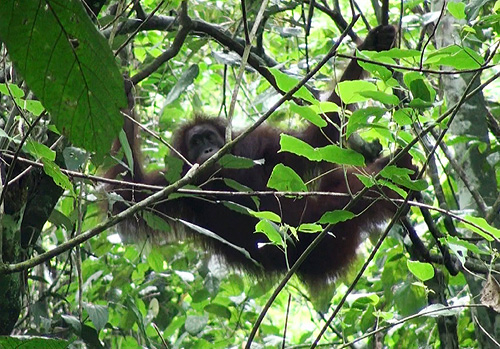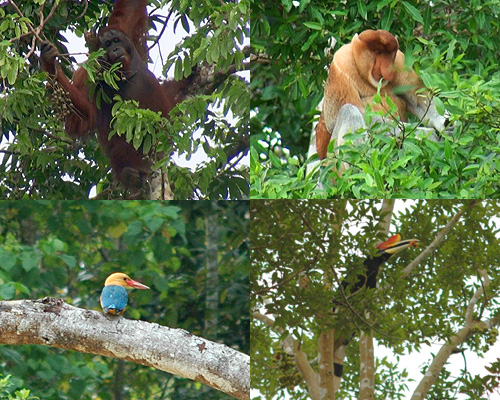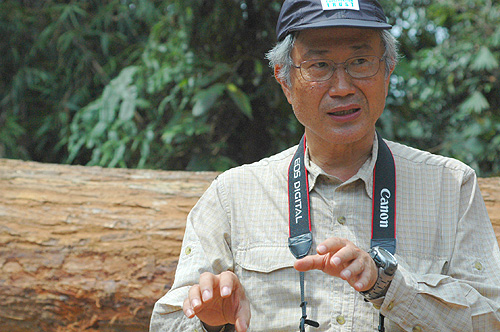
from Malaysia vol. 48 2009.11.27 Can we build a green relationship? - What's happening in the tropical rainforests of Borneo
![]()
Palm oil is a vegetable oil widely used around the world because it is "inexpensive" and is "gentle on the body." It is used in a great range of products including food, soaps, and cosmetics. Oil palm plantations are expanding rapidly in response to the growing global demand for palm oil. Did you know that, as a result, wildlife living in the tropical rainforests is being forced to the brink of extinction? Biodiversity loss is a key aspect of the environmental issues we face today. To learn more about what is actually happening there, I visited a tropical rainforest on the island of Borneo in Malaysia.
Back to Table of Contents To Borneo, an island with dense tropical rainforests
I was able to write this report by taking part in the Tohoku University Ecosystem Adaptability Global COE Program consortium led by Professor Tohru Nakashizuka, who kindly supervised the publication of our book, "Ikimonogatari." The key objective of this program is to provide doctoral students with opportunities to visit forestry ecosystem so that they can conduct research onsite as part of their graduate education. The destination was Borneo, the 3rd largest island in the world. The program was comprised of various content including the inspection of an FSC certified forest, which is still rare in Southeast Asia, as well as lectures on forest policies of the Sabah and Sarawak states, but in this report, I would like to mainly focus on the current situation in the lower reach of the Kinabatangan River located in the state of Sabah in northeastern Borneo. As one of the writers of the "Ikimonogatari," I introduced conservation activities being undertaken in the area, but this was my first trip to Borneo. I was astounded by what I saw and learned there.

Back to Table of Contents Oil palms stretch all the way to the horizon
When I arrived in Malaysia, I was truly stunned by the vast oil palm plantations that stretched out to the horizon. When you look out of the airplane window, at a glance it looked as though the land is endowed with rich, green nature, but it is actually covered with a single type of plant. When you get closer to the plantation, you will see that there are hardly any insects or birds near the oil palm trees. I was told that there are rats that come to feed on the fruit and cobras that prey on these rats, which seemed like quite a savage food chain.
 The oil palm plantation stretches as far as the horizon.
The oil palm plantation stretches as far as the horizon.
 The plantation looks like a very rich, green environment at first glance but
The plantation looks like a very rich, green environment at first glance but
Why has the palm oil industry expanded? There are several reasons. Its yield per unit area is far higher than any other vegetable oil, it can be harvested year round, it is inexpensive, and unlike petroleum it can be reproduced and does not become depleted. As you can see, its advantages as a resource are the main reason why the industry has expanded exponentially. There was even a time when people believed that palm oil plantations were "environmentally friendly" because although the tropical rainforests may be cut down to make room for plantations, you are still planting vegetation that absorbs CO2. Today, it has taken the lead with respect to global vegetable oil production, only second to soy oil. As a result, the total surface area dedicated to plantations in Malaysia was only 1 million hectares in 1980, but by 2008 it had increased to 4.8 million hectares (according to the MPOA). This is more than 20 times the area of Tokyo prefecture. Japan imports 550,000 tons of the 15.4 million tons of palm oil Malaysia exports annually. Globally, 38 million tons of palm oil is produced, so it has now become a mega industry and a significant part of the world economy.
 Fruit cluster (bunch) of an oil palm tree.
Fruit cluster (bunch) of an oil palm tree.
 The oil palm fruit and its cross section.
The oil palm fruit and its cross section.
Oil palm trees grow to a height of approximately 20 meters and produce about 10-12 clusters. A few hundred fruit can be collected from each cluster that can weigh more than 30kg and both the fruit and seeds contain high volume of oil. Since the quality of oil palm fruits deteriorates immediately after harvest, they have to be processed within 24 hours. That is why oil mill factories must be located near plantations. In addition, you need at least 4,000 hectares of land to have an economically viable factory. And this is why much of the land has been transformed into plantations.
 A palm oil factory in Sarawak. Trucks transporting fruit clusters of oil palm trees arrive at the factory one after another.
A palm oil factory in Sarawak. Trucks transporting fruit clusters of oil palm trees arrive at the factory one after another.
 A row of massive tanks.
A row of massive tanks.
Palm oil has become an intricate part of our lives. More than 80% of food products such as snacks, chocolate, ice cream, frozen food, instant noodles, and margarine contain palm oil. Soaps, detergents, cosmetics, and candles are examples of non-food products containing palm oil. There is probably not a single day that we don't come across or eat anything containing palm oil. Although Japan's consumption of palm oil is lower than that of Western countries, the annual average per capita palm oil consumption is said to be 37 liters.
Back to Table of Contents Orangutans in danger - a tragic wildlife sanctuary
Expansion of the palm oil industry is driving wild animals in the tropical rainforest to extinction. For example, in the lower reach of the Kinabatangan River in the state of Sabah in northeastern Borneo, wild animals including orangutans are on the verge of extinction. This region was once covered by lush tropical rainforests, but the forests have been divided into fragments due to the expansion of oil palm plantations. As a result, wild animals in the rainforests have been confined to a much smaller habitat. Animals need a certain amount of space in order to survive. Living in a small forest makes it more difficult for them to find enough food and mating partners. Orangutans are one of the endangered species. It is said that wild orangutans require more than 70,000 hectares of forest to survive. According to the survey conducted in 2003, there are currently 1,125 orangutans living in the 27,000 hectares of protected land. The Cardiff University researchers estimate that if forests continue to become fragmented, 95% of the orangutan population will become extinct in 50 years time.
 The Kinabatangan River.
The Kinabatangan River.
We took a ride in a boat to observe the wild animals that live along the river. There, we encountered the original inhabitants of the forest. We saw many animals such as orangutans, crab-eating macaques, Asian house martins, kingfishers, red leaf monkeys, crocodiles, Borneo elephants, gibbons, and proboscis monkeys. We were told that we were particularly lucky to have run into so many animals, but relatively speaking, you can observe many wild animals in this area and so eco tours of the region are quite popular, and there are numerous cozy lodges or camping sites being built along the river.
 Animals we encountered: a male orangutan (upper left), proboscis monkey (upper right), kingfisher (lower left), and hornbill (lower right)
Animals we encountered: a male orangutan (upper left), proboscis monkey (upper right), kingfisher (lower left), and hornbill (lower right)
But why can we see such a wide variety of wildlife here? There is a sad story behind it. If you look carefully, although some woodland remains along the river, you can see that the plantation is closing in. The animals have fled to this narrow strip of forest to find a place to live and that is why you can find a wide range of animals along the river. Some oil palms are also being planted illegally in the protected areas. If you visit this place without knowing the circumstances, it may seem like a sanctuary for animals surrounded by a rich waterfront and forests, but it is actually a tragic sanctuary to which we, humans, have forcefully confined the animals to. The orangutan in the photo is the last male left in this area.
 Plantations closing in on the river.
Plantations closing in on the river.
View Larger Map
A satellite image of the Segama River basin located south of the Kinabatangan River; wildlife extinction is also a concern in this region. You can see from the image how the forests are concentrated in a narrow area along the river and how the fragmented forests have become isolated, surrounded on all sides by the vast plantation, like small islands in the sea.
A male gibbon calling wistfully for a female on the other side of the river. Because forests have become fragmented, they cannot meet in person (or rather, gibbon). Drainage from plantations or rivers becomes natural barriers for gibbons, a species of primates, like orangutans, that cannot swim. So the inability to find a mate on the same side of the river leads directly to extinction.
Back to Table of Contents Reinforcing the green relationship - activities of the Borneo Conservation Trust
Borneo Conservation Trust (BCT) is an NGO engaged in conservation activities of wildlife in the lower reach of the Kinabatangan River. Dr. Toshinori Tsubouchi, a representative of Borneo Conservation Trust Japan (BCTJ) and associate professor of Seisa University, says, "What we (people in developed countries) think is convenient and useful in our daily lives is actually causing the rainforests to become fragmented and isolating the animals. I want people to be aware of this fact because I believe that not being aware of the truth is, in a way, a sin."
 Dr. Toshinori Tsubouchi, Chief Operating Officer of BCTJ.
Dr. Toshinori Tsubouchi, Chief Operating Officer of BCTJ.
BCT undertakes a wide range of activities. Dr. Tsubouchi, who was a veterinarian, wants to establish a wildlife rescue center. Having run out of food in the narrow strip of forest, wild animals such as Borneo elephants sometimes wander into the plantations looking for food. These animals get caught in traps set by workers who attempt to supplement their low income by obtaining wild animal meat. Dr. Tsubouchi would like to rescue such animals rather than stand by doing nothing and watch them die. BCT is also calling for the creation of "Green Corridors" by re-connecting fragmented forests thereby helping prevent the extinction of wildlife. This plan aims to purchase back plantation land, restore the forest back to its original state, and to create pathways for animals by connecting fragmented forests together. It is said that we can help avoid wildlife extinction by purchasing 20,000 hectares of land along the Kinabatangan River and the Segama River in the south and creating these corridors. According to the research conducted by the Cardiff University, we can reduce the risk of orangutans becoming extinct in 50 years time to 5% by building green corridors. The land costs approximately 1.2 million yen per hectare (as of September 2009). There is still a long way to go to, but the number of sponsors is increasing thanks to the efforts of Dr. Tsubouchi and other members, and so they have been able to buy back plantation land little by little (currently, they are raising funds for Lot 3 and Lot 4). In addition to purchasing lands, as part of its efforts to connect fragmented forests, BCT is also undertaking the "bridge of life" project, which builds suspension bridges for orangutan in places where the river is narrower with the help from zoos and bridge architects in Japan.
 A suspension bridge constructed in April 2008 using fire hoses. Unfortunately, there has been no report of an orangutan crossing the bridge so far.
A suspension bridge constructed in April 2008 using fire hoses. Unfortunately, there has been no report of an orangutan crossing the bridge so far.
I saw a Proboscis monkey crossing the bridge during our visit. So this fire hose bridge is successfully fulfilling its role to connect the forests. If we could only get an orangutan to cross it!
Back to Table of Contents Developing a sustainable palm oil industry
There are companies that have become aware of the environmental problems caused by palm oil and have begun to take action. Saraya Co., LTD., a soap and detergent manufacturer, took part in the establishment of BCT and has been supporting its activities ever since. Saraya has promised its consumers to donate 1% of the proceeds of "Yashinomi," the company's representative botanical detergent, to BCT's "Green Corridor" project and is implementing various initiatives including the "bridge of life" project for orangutans and activities to save injured Borneo elephants. You can see how serious Saraya is about its commitment through other initiatives such as the "Borneo Investigation" activities where selected consumers report about what they saw onsite during the inspection and share that information on the website. According to Mr. Hirotsugu Daishima, director of BCTJ and General Manager of Marketing, Advertising and Publicity Department of Saraya, who has guided us in Borneo together with Dr. Tsubouchi, the company is striving to strike a balance between its business and biodiversity conservation by reexamining the way palm oil business should be conducted through these activities.
An example of a more international commitment is RSPO (Roundtable on Sustainable Palm Oil), which was formed in 2004 backed by the WWF. It brings together companies that are part of the palm oil industry, NGOs, and governments to brainstorm about making the palm oil industry sustainable for both humans and wildlife. Although discussions just started, if certification platforms and other measures come into place, it may give consumers the option to choose products made with environmental-conscious oil. As of 2009, 6 companies including Saraya from Japan have joined RSPO.
It is not realistic to stop oil palm production right this minute. As the world population grows and people's lives become richer, consumption continues to increase. How do we strike a balance between meeting the needs of the world economy and conservation of biodiversity, which is absolutely essential? We must also take into consideration the local economy that supports the lives of the local people. Dr. Tsubouchi emphasizes that in the field you can't just think and theorize in your head when taking action. There are people who attempt to inhibit forest preservation using force and there have been cases where people have been wounded or killed. Standing there at the actual site, I was blown away by the complexity of the problem. I very much admire Dr. Tsubouchi and other members' passion and dedication; they refuse to give up and continue to make headway despite the circumstances.
If we just sit here and do nothing while wild animals become extinct just for short-term, immediate benefits, it will be our turn next to go extinct. We cannot survive without nature's blessings. The problems regarding oil palm reminds me of the problems associated with bio-ethanol production using corn and soybeans. Rapid and excessive expansion of production ultimately leads to irreversible destruction of nature. The 10th Conference of the Parties to the Convention on Biological Diversity (COP 10) is scheduled to take place in Nagoya in 2010. We need to face these issues and come up with ingenuous ways that help strike a balance between the economy and ecosystem conservation as soon as possible. Dr. Tsubouchi says, "What we need are green relationships that bind mankind and the ecosystems together." His words have stayed in my head. I sincerely hope this report will help people get a better idea about what is really going on.
An orangutan we found near the Gomantong Caves. The future of these orangutans is our future.
Reported and orginal Japanese text written by: Soichi Ueda (Think the Earth Project)
Translated by: Yuri Morikawa (oxygen inc.)
Photographs by Soichi Ueda (Think the Earth Project)
Special thanks to: Tohoku University Ecosystem Adaptability Global COE, Borneo Conservation Trust, Saraya Co., LTD















